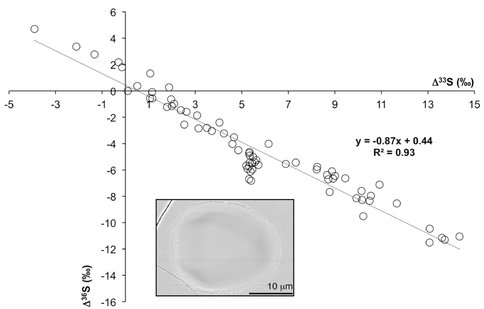2012 Annual Science Report
 University of Wisconsin
Reporting | SEP 2011 – AUG 2012
University of Wisconsin
Reporting | SEP 2011 – AUG 2012
Project 3B: In Situ S Isotope Studies in Archean-Proterozoic Sulfides
Project Summary
Studies of sulfur isotopes constrain atmospheric and marine conditions in the Paleoproterozoic and Archean. We have developed capabilities for analysis of all four sulfur isotopes, including the rarest isotope (36-S) in situ by ion microprobe. In general sulfur 4 isotope data from Archean sulfides fall on the reference array for mass independent fractionation that was established by earlier bulk measurements. Small deviations from the array are resolved and likely result from biological or environmental forcings.
Project Progress
Since the pioneering discovery reported by Farquhar et al. in 2000 that the rarer isotopes of sulfur (33S and 36S) show mass independent fractionation (S-MIF; Δ33S or Δ36S ≠ 0) in rocks older than ~2.4 Ga, a large body of work has emerged that concerns the degree to which these isotopes record information about atmospheric redox state and microbial metabolism. Since the earliest studies, the range of S-MIF observed in the rock record has expanded significantly, and consistent trends have emerged. One such observation is that Archean sulfur four isotope data tend to plot on a “reference array” with a Δ36S/Δ33S slope of ~ –0.9. Recently, a correlation has been observed between departures from this reference array and extremely low δ13Corg values in Neoarchean drill core samples, interpreted to represent the intermittent influence of an organic haze on atmospheric production of S-MIF. Laboratory culture experiments supported by models have revealed that mass dependent sulfur isotope fractionation effects in metabolic networks combine to generate small deviations in Δ33S and Δ36S that can be used to distinguish the variable expression of different sulfur metabolisms in the rock record.
This year, techniques were developed at WiscSIMS for the simultaneous measurement of all four stable isotopes of sulfur in order to evaluate whether in situ measurements at the micrometer scale could be used effectively to address some of these emerging paleoenvironmental and biogeochemical questions. In an initial proof of concept study, 33 sulfur four isotope analyses of detrital pyrite in a glacial diamictite from the ~2.4 Ga Meteorite Bore Member of Western Australia, and 58 such analyses of pyrite in the ~2.5 Ga Mount McRae Shale, the ~2.6 Ga Carrawine Dolomite, and the ~2.6 Ga Jeerinah Shale were conducted. Using a ~25 × 20 micrometer spot, average external precision for these analyses (2 SD; based on 116 analyses of the UWPy-1 Balmat pyrite standard) was 0.25‰, 0.05‰, and 0.85‰ for δ34S, Δ33S, and Δ36S, respectively. A regression including all 95 sample analyses yields a line with Δ36S/Δ33S slope –0.87 and r2 = 0.93. Slight deviations within this overall trend are resolved, and these may be related to the atmospheric and/or biological effects discussed above.
Results of 95 SIMS in situ sulfur four isotope analyses of pyrite from six rock samples ranging in age from ~2.6 to ~2.4 Ga. Analyses fall on the Archean “reference array” with a Δ36S/Δ33S slope of –0.9, and r2 = 0.93. Slight deviations are resolved within individual samples, and these may result from atmospheric and/or biological effects. Inset shows a backscattered electron image of a representative ~25 μm analytical pit made during this session.
Publications
-
Williford, K. H., Van Kranendonk, M. J., Ushikubo, T., Kozdon, R., & Valley, J. W. (2011). Constraining atmospheric oxygen and seawater sulfate concentrations during Paleoproterozoic glaciation: In situ sulfur three-isotope microanalysis of pyrite from the Turee Creek Group, Western Australia. Geochimica et Cosmochimica Acta, 75(19), 5686–5705. doi:10.1016/j.gca.2011.07.010
-
PROJECT INVESTIGATORS:
-
PROJECT MEMBERS:
Reinhard Kozdon
Co-Investigator
Jennifer Eigenbrode
Collaborator
James Schopf
Collaborator
Ken Sugitani
Collaborator
Roger Summons
Collaborator
Martin Van Kranendonk
Collaborator
Malcolm Walter
Collaborator
Kenneth Williford
Postdoc
-
RELATED OBJECTIVES:
Objective 2.1
Mars exploration.
Objective 4.1
Earth's early biosphere.
Objective 5.2
Co-evolution of microbial communities
Objective 6.1
Effects of environmental changes on microbial ecosystems
Objective 7.1
Biosignatures to be sought in Solar System materials

